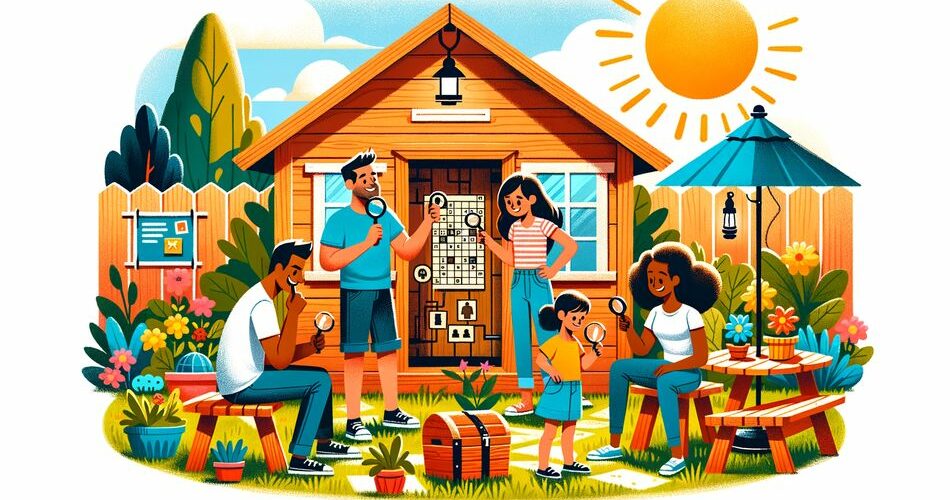Welcome to Growing Together, where we provide expert parenting tips and child development advice to support your parenting journey from newborns to teens. Today, we’re venturing into the exciting world of backyard escape rooms—a fun, interactive way to nurture teamwork, creativity, and critical thinking in your family. Building a backyard escape room can turn a regular weekend into an unforgettable adventure that encourages collaboration and problem-solving skills. Let’s dive into how you can build your own backyard escape room and unlock hours of fun for your whole family.
Planning Your Backyard Escape Room
Creating a backyard escape room begins with a solid plan. Start by determining the theme of your escape room. This could be anything from a pirate treasure hunt to a spy mission or even an enchanted forest. The theme sets the tone for your puzzles, decorations, and storyline.
Next, consider the age and skill level of the participants. For younger children, you might include simpler puzzles and more imaginative play, while older kids and adults can handle more complex challenges. It’s essential to strike a balance to ensure everyone has a good time.
A successful escape room also needs a gripping storyline. Write a backstory that explains why the players are there and what their ultimate goal is. For example, they might need to find a hidden treasure to save the day or to escape from a villain’s lair. The storyline will guide the entire experience and keep everyone engaged.
Designing Your Puzzles
The heart of any escape room is its puzzles. They should be varied and require different types of thinking—logic, physical dexterity, pattern recognition, etc. Here’s a step-by-step guide to designing them:
- Start Simple: Especially for families, it’s good to have the first puzzle be straightforward to build confidence and get everyone in the game.
- Incorporate Clues: Scatter clues around the yard that link to each other, leading the players to the final goal. This could include hidden keys, coded messages, or objects that need to be arranged in a certain order.
- Use Everyday Items: Utilize items you already have at home. A garden hose can become a snake that needs to be ‘charmed’ in a particular way, or patio furniture can be rearranged as part of the challenge.
- Create Physical Challenges: For example, if you have a trampoline, maybe they have to jump a certain number of times or retrieve something from the trampoline.
- Include Decoys: Not every clue should be useful. Throw in some red herrings to make it more challenging and exciting.
Setting Up the Escape Room
Once you’ve designed your puzzles, it’s time to set up the escape room. Transform your backyard to fit the theme using decorations, props, and sound effects if possible. A few tips for an immersive experience:
- Use blankets, sheets, and tarps to create different ‘rooms’ or areas within your backyard.
- Draw or print out images relevant to your theme. For a pirate theme, treasure maps and pirate flags are a must!
- Use a portable speaker to play theme-related background music or sound effects to elevate the ambiance.
- Include a countdown timer to add excitement and urgency. A kitchen timer or a countdown app on a phone can work perfectly.
Playing the Game
With everything set up, gather the family and explain the storyline, the objective, and any ground rules. Give everyone a role based on their strengths. Don’t forget to take on a role as well, whether as the game master guiding the players or a character in the story.
During the game, encourage teamwork by prompting players to communicate and collaborate. If anyone gets stuck, be ready with hints that can guide them without solving the puzzle for them. Remember, the goal is to have fun and work together, not to create frustration.
Reflecting and Celebrating
After everyone has completed the escape room, gather the family to reflect on the experience. Discuss what worked, what didn’t, and what everyone enjoyed the most. Celebrate the teamwork and the achievements, no matter how big or small.
Consider celebrating with a themed snack or treat that ties back into the story. If you did a pirate treasure hunt, maybe enjoy some “gold coin” chocolates or fruit punch “grog.” This can put a delightful end to the adventure and create lasting memories.
Conclusion
Building a backyard escape room is more than just a fun activity; it’s a way to bring the family together, promote teamwork, and foster problem-solving skills. With some creativity and planning, you can transform a regular day into an extraordinary adventure. We hope this guide has inspired you to create your own backyard escape room. Here’s to unlocking countless hours of family fun and teamwork!
Stay tuned to Growing Together for more exciting and educational family activities, expert parenting tips, and child development advice. Together, we can make every moment a chance to grow and connect.

